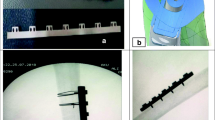Abstract
Purpose
The femoral head expandable peg offers a new concept of bone-device purchase treating proximal femur fractures. We describe the expansion influence on both the periimplant bone properties and the intraosseous pressure.
Methods
A 10 × 8 mm cannulated peg consisting of a stainless steel oval-shaped transversely sectioned rod was tested on 13 femoral heads retrieved from patients with subcapital fracture treated by hemiarthroplasty. Normal saline solution was used to expand the diameter of its membrane from 7.8 to 10.5 mm, resulting in abutment of the distal peg to the compacted cancellous bone of the femoral head. The intraosseous pressure was monitored using a 1.4 mm drill-hole.
Results
Dual-energy X-ray absorptiometry and microradiography demonstrated increased periimplant bone density following peg expansion, without significant increase in the intraosseous pressure.
Conclusion
The new implant afforded improved periimplant bone density, less trabecular damage and preservation of bone stock, all contributing to reliable biomechanical support and potentially decreasing the high complication rate following screw fixation in osteoporotic femora. Further studies are needed in order to establish clinical safety and efficacy.





Similar content being viewed by others
References
An YH, Bensen CV (2000) General considerations of mechanical testing. In: An YH, Draughn RA (eds) Mechanical testing of bone and the bone-implant interface. CRC Press LLC, Florida, pp 120–122
Barrios C, Brostrom LA, Stark A, Walheim G (1993) Healing complications after internal fixation of trochanteric hip fractures: the prognostic value of osteoporosis. J Orthop Trauma 7:438–442
Binderman I, Adut M, Yaffe A (2000) Effectiveness of local delivery of alendronate in reducing alveolar bone loss following periodontal surgery in rats. J Periodontol 71:1236–1240
DeLee JC (1996) Fractures and dislocations of the hip. In: Rockwood CA, Green DP (eds) Fractures in adults. Lippincott-Raven, Philadelphia, pp 1732
Downey DJ, Simkin PA, Taggart R (1988) The effect of compressive loading on intraosseous pressure in the femoral head in vitro. J Bone Joint Surg (Am) 70:871–877
Ficat RP (1985) Idiopathic bone necrosis of the femoral head. Early diagnosis and treatment. J Bone Joint Surg (Br) 67:3–9
Ganz R, Thomas RJ, Hammerle CP (1979) Trochanteric fractures of the femur: treatment and results. Clin Orthop 138:30–40
Harrington KD (1975) The use of methylmethacrylate as an adjunct in the internal fixation of unstable comminuted intertrochanteric fractures in osteoporotic patients. J Bone Joint Surg (Am) 57:744–750
Haynes RC, Poll RG, Miles AW, Weston RB (1997) Failure of femoral head fixation: a cadaveric analysis of lag screw cut-out with the gamma locking nail and AO dynamic hip screw. Injury 28:337–341
Hinton RY, Smith GS (1993) The association of age, race, and sex with the location of proximal femoral fractures in the elderly. J Bone Joint Surg (Am) 75:752–759
Gullberg B, Johnell O, Kanis JA (1997) World-wide projections for hip fracture. Osteoporos Int 7(5):407–413
Krischak GD, Augat P, Wachter NJ et al (1999) Predictive value of bone mineral density and Singh index for the in vitro mechanical properties of cancellous bone in the femoral head. Clin Biomech 14:346–351
Laros GS, Moore JF (1974) Complications of fixation in intertrochanteric fractures. Clin Orthop 101:110–119
Larsson S, Elloy M, Hansson LI (1988) Fixation of unstable trochanteric hip fractures. A cadaver study comparing three different devices. Acta Orthop Scand (Denmark) 59:658–663
Lepore S, Capuano N, Lepore L, Romano G (2000) Preliminary clinical and radiographic results with the Fixion intramedullary nail: an inflatable self-locking system for long bone fractures. J Orthop Trauma 1:135–140
Richards RH, Evans G, Egan J, Shearer JR (1990) The AO dynamic hip screw and the Pugh sliding nail in femoral head fixation. J Bone Joint Surg (Br) 72:794–796
Scott WA, Allum RL, Wright KWJ (1985) Implant-induced trabecular damage in cadaveric femoral necks. Acta Orthop Scand 56:145–146
Shasha N, Blumberg N, Tauber M, Dekel S (2002) An expandable intramedullary nail for fixation in osteoporotic bone. In: An YH (eds) Internal fixation in osteoporotic bone. Thieme Medical Publishers, New York, pp 301–309
Smith MD, Cody DD, Goldstein SA et al (1992) Proximal femoral bone density and its correlation to fracture load and hip-screw penetration load. Clin Orthop 283:244–251
Steinberg EL, Blumberg N, Dekel S (2005) The Fixion femur nailing system: biomechanical properties of the nail and a cadaveric study. J Biomech 38(1):63–68
Trevisan C, Bigoni M, Cherubini R et al (1993) Dual X-ray absorptiometry for the evaluation of bone density from the proximal femur after total hip arthroplasty: analysis protocols and reproducibility. Calcif Tissue Int 53:158–161
Wolfgang GL, Bryant MH, O’Neill JP (1982) Treatment of intertrochanteric fracture of the femur using sliding screw plate fixation. Clin Orthop 163:148–158
Yoshimine F, Latta LL, Milne EL (1993) Sliding characteristics of compression hip screws in the intertrochanteric fracture: a clinical study. J Orthop Trauma 7:348–353
Author information
Authors and Affiliations
Corresponding author
Rights and permissions
About this article
Cite this article
Blumberg, N., Shasha, N., Tauber, M. et al. The femoral head expandable peg: improved periimplant bone properties following expansion in a cadaveric model. Arch Orthop Trauma Surg 126, 526–532 (2006). https://doi.org/10.1007/s00402-006-0188-4
Received:
Published:
Issue Date:
DOI: https://doi.org/10.1007/s00402-006-0188-4




